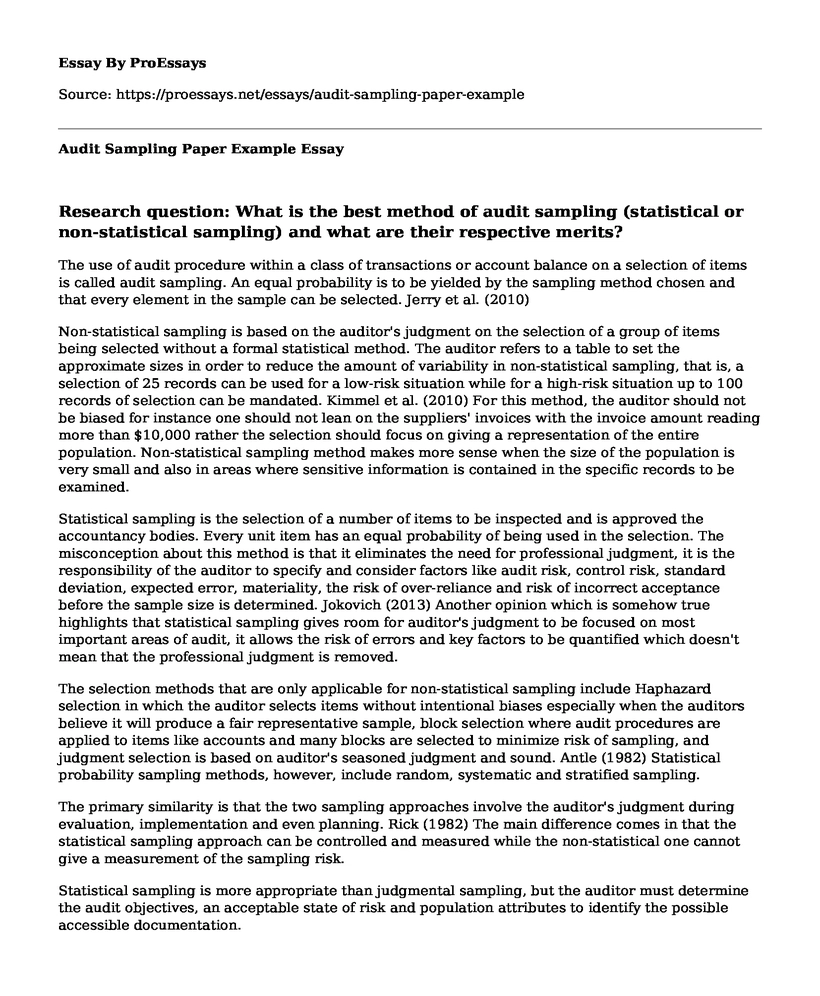Research question: What is the best method of audit sampling (statistical or non-statistical sampling) and what are their respective merits?
The use of audit procedure within a class of transactions or account balance on a selection of items is called audit sampling. An equal probability is to be yielded by the sampling method chosen and that every element in the sample can be selected. Jerry et al. (2010)
Non-statistical sampling is based on the auditor's judgment on the selection of a group of items being selected without a formal statistical method. The auditor refers to a table to set the approximate sizes in order to reduce the amount of variability in non-statistical sampling, that is, a selection of 25 records can be used for a low-risk situation while for a high-risk situation up to 100 records of selection can be mandated. Kimmel et al. (2010) For this method, the auditor should not be biased for instance one should not lean on the suppliers' invoices with the invoice amount reading more than $10,000 rather the selection should focus on giving a representation of the entire population. Non-statistical sampling method makes more sense when the size of the population is very small and also in areas where sensitive information is contained in the specific records to be examined.
Statistical sampling is the selection of a number of items to be inspected and is approved the accountancy bodies. Every unit item has an equal probability of being used in the selection. The misconception about this method is that it eliminates the need for professional judgment, it is the responsibility of the auditor to specify and consider factors like audit risk, control risk, standard deviation, expected error, materiality, the risk of over-reliance and risk of incorrect acceptance before the sample size is determined. Jokovich (2013) Another opinion which is somehow true highlights that statistical sampling gives room for auditor's judgment to be focused on most important areas of audit, it allows the risk of errors and key factors to be quantified which doesn't mean that the professional judgment is removed.
The selection methods that are only applicable for non-statistical sampling include Haphazard selection in which the auditor selects items without intentional biases especially when the auditors believe it will produce a fair representative sample, block selection where audit procedures are applied to items like accounts and many blocks are selected to minimize risk of sampling, and judgment selection is based on auditor's seasoned judgment and sound. Antle (1982) Statistical probability sampling methods, however, include random, systematic and stratified sampling.
The primary similarity is that the two sampling approaches involve the auditor's judgment during evaluation, implementation and even planning. Rick (1982) The main difference comes in that the statistical sampling approach can be controlled and measured while the non-statistical one cannot give a measurement of the sampling risk.
Statistical sampling is more appropriate than judgmental sampling, but the auditor must determine the audit objectives, an acceptable state of risk and population attributes to identify the possible accessible documentation.
Keywords
Sampling
Control risk
Materiality
Audit risk
References
Kimmel, Paul D., Jerry J. Weygandt, and Donald E. Kieso. Accounting: Tools for business decision makers. John Wiley & Sons, 2010.
Jokovich, Ghanzov. "Statistical Sampling in Auditing." International Journal of Accounting and Financial Management 16 (2013): 892-898.
Antle, Rick. "The auditor as an economic agent." Journal of Accounting Research (1982): 503-527.
Cite this page
Audit Sampling Paper Example. (2022, Nov 06). Retrieved from https://proessays.net/essays/audit-sampling-paper-example
If you are the original author of this essay and no longer wish to have it published on the ProEssays website, please click below to request its removal:
- How Black Monday Rocked Global Stock Markets
- The Accounting Profession and Bankrate Case Paper Example
- Bibliographic or Reference Entry Essay
- Banker's Acceptance - Essay Sample
- Paper Example on Comparing Capital Expenditure of Apple Inc. and Samsung
- ING: Growing Into a Global Banking Giant - Essay Sample
- Filing a Dispute to Amendment Assessment and Limits







